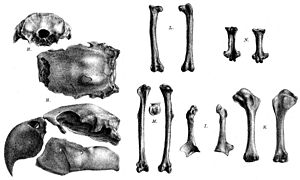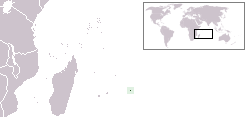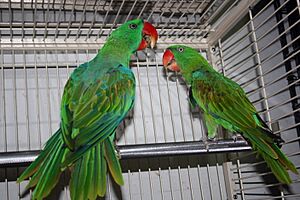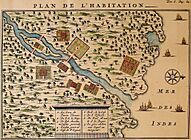Rodrigues parrot facts for kids
Quick facts for kids Rodrigues parrot |
|
|---|---|
 |
|
| Subfossil skull and limb bones, 1879 | |
| Conservation status | |
| Scientific classification | |
| Genus: |
Necropsittacus
|
| Species: |
rodricanus
|
 |
|
| Location of Rodrigues | |
| Synonyms | |
|
|
The Rodrigues parrot or Leguat's parrot (Necropsittacus rodricanus) was a type of parrot that is now extinct. This means it no longer exists anywhere in the world. It lived only on the island of Rodrigues, which is part of the Mascarene islands. Scientists know about this parrot from old bones found in the ground, called subfossils, and from descriptions written by people long ago.
The Rodrigues parrot was a green bird. It had a very large head and beak, and a long tail. We don't know its exact size, but it might have been about 50 centimeters (20 inches) long. It was the biggest parrot on Rodrigues. It also had the largest head of any parrot from the Mascarene islands. This parrot might have looked a bit like the great-billed parrot.
When people first found this parrot, it often lived and nested on small islands near southern Rodrigues. These islets were safer because there were no introduced rats there. The parrots ate seeds from a shrub called Fernelia buxifolia. The last time anyone mentioned seeing the Rodrigues parrot was in 1761. It likely died out soon after. This was probably due to new animals hunting them, forests being cut down, and people hunting them for food.
Contents
Discovering the Rodrigues Parrot
People first wrote about birds that might have been the Rodrigues parrot in 1708. A French traveler named François Leguat described them in his book, A New Voyage to the East Indies. Leguat was the leader of a group of French refugees. They lived on Rodrigues island between 1691 and 1693.
Later, a French sailor named Julien Tafforet wrote about the island in 1726. He was also stuck on Rodrigues. Then, in 1761, a French astronomer named Alexandre Pingré visited the island. He went there to watch a rare event called the 1761 transit of Venus. He also wrote about the parrots he saw.
Naming the Parrot
In 1867, a French scientist named Alphonse Milne-Edwards studied some old bird bones. These bones came from Rodrigues island. They were found by Edward Newton, a British official. Among the bones was a piece of an upper beak. Milne-Edwards realized it belonged to a parrot.
Based on this beak, he gave the new species a scientific name: Psittacus rodricanus. The name rodricanus comes from Rodrigues island. The island itself is named after its discoverer, Diogo Rodrigues. Milne-Edwards later changed the parrot's genus name to Necropsittacus in 1873. This new name means "dead parrot" in Greek, because the bird was extinct.
Scientists later found more bones of the Rodrigues parrot in 1879. These included a skull and leg bones. Not many fossils of this parrot exist. However, some have been found in caves on the Plaine Corail and in Caverne Tortue.
How the Rodrigues Parrot Evolved
Many birds unique to the Mascarene islands, like the dodo, came from ancestors in South Asia. Scientists think this might be true for all the parrots there too. During the Pleistocene ice age, sea levels were lower. This made it easier for birds to travel to islands that are now far apart.
Most extinct parrots from the Mascarenes are not well known. But their fossil bones show they had some things in common. They had large heads and jaws, smaller chest bones, and strong leg bones. Scientists believe the Rodrigues parrot was closely related to the broad-billed parrot from Mauritius. This is because they both had large jaws.
Scientists think that parrots from a group called Psittaculini might have spread to the Mascarene islands many times. This group of parrots has managed to live on many distant islands in the Indian Ocean.
What the Rodrigues Parrot Looked Like
The Rodrigues parrot was described as the biggest parrot on the island. It had a large head and a long tail. Its feathers were all green. Its skull was flatter than most other parrots' skulls. However, it was similar to the skulls of parrots in the genus Ara.
We don't know its exact body length, but it might have been about 50 centimeters (20 inches) long. This is similar to the size of a large cockatoo. Its head was proportionally the largest of any parrot species from the Mascarene islands.
The bones of the Rodrigues parrot were similar to those of Tanygnathus and Psittacula parrots. It might have looked like the great-billed parrot when it was alive. But it would have had a larger head and tail.
Life and Habits of the Rodrigues Parrot

The most detailed description of the Rodrigues parrot comes from Julien Tafforet in 1726:
The largest are larger than a pigeon, and have a tail very long, the head large as well as the beak. They mostly come on the islets which are to the south of the island, where they eat a small black seed, which produces a small shrub whose leaves have the smell of the orange tree, and come to the mainland to drink water ... they have their plumage green.
Tafforet also said that the parrots ate seeds from a shrub called Fernelia buxifolia. This plant is rare today, but it was common on Rodrigues and nearby islets back then. Leguat mentioned that the parrots on the island ate nuts from the Cassine orientalis tree.
Because many rats were brought to Rodrigues, the parrots, along with the Rodrigues starling and the Rodrigues pigeon, often went to and nested on small islands offshore. These islets were safer because rats were not present there.
Many other unique animals on Rodrigues died out after humans arrived. The island's ecosystem (all the living things and their environment) is now very damaged. Before humans, forests covered the whole island. But very little forest remains today because of deforestation (cutting down trees).
The Rodrigues parrot lived alongside other birds that are now extinct. These included the Rodrigues solitaire, the Rodrigues rail, Newton's parakeet, the Rodrigues starling, the Rodrigues scops owl, the Rodrigues night heron, and the Rodrigues pigeon. Extinct reptiles included two types of giant tortoises and the Rodrigues day gecko.
Why the Rodrigues Parrot Disappeared
Only one of the eight parrot species unique to the Mascarene islands has survived. This is the echo parakeet of Mauritius. The other parrots likely died out because of too much hunting and forests being cut down by humans.
Like the main island of Rodrigues, the small offshore islets eventually had rats. These rats likely ate the parrots' eggs and chicks. Cats, which were also brought to the island, may have hunted the remaining birds too.
Leguat mentioned that people ate local parrots. It's not clear if the green parrots he talked about were the Rodrigues parrot or a green Newton's parakeet:
There are abundance of green and blew Parrets, they are of a midling and equal bigness; when they are young, their Flesh is as good as young Pigeons.
Pingré wrote in 1761 that local birds were popular for hunting. He also noticed that the Rodrigues parrot was becoming rare:
The perruche [Newton's parakeet] seemed to me much more delicate [than the flying-fox]. I would not have missed any game from France if this one had been commoner in Rodrigues; but it begins to become rare. There are even fewer perroquets [Rodrigues parrots], although there were once a big enough quantity according to François Leguat; indeed a little islet south of Rodrigues still retains the name Isle of Parrots [Isle Pierrot].
Pingré also reported that people were cutting down forests on the island. Tortoise hunters would set fires to clear plants. This, along with direct hunting of the parrots, likely caused the number of Rodrigues parrots to drop. Pingré's account from 1761 is the last time anyone mentioned seeing the species. It probably became extinct soon after that.





